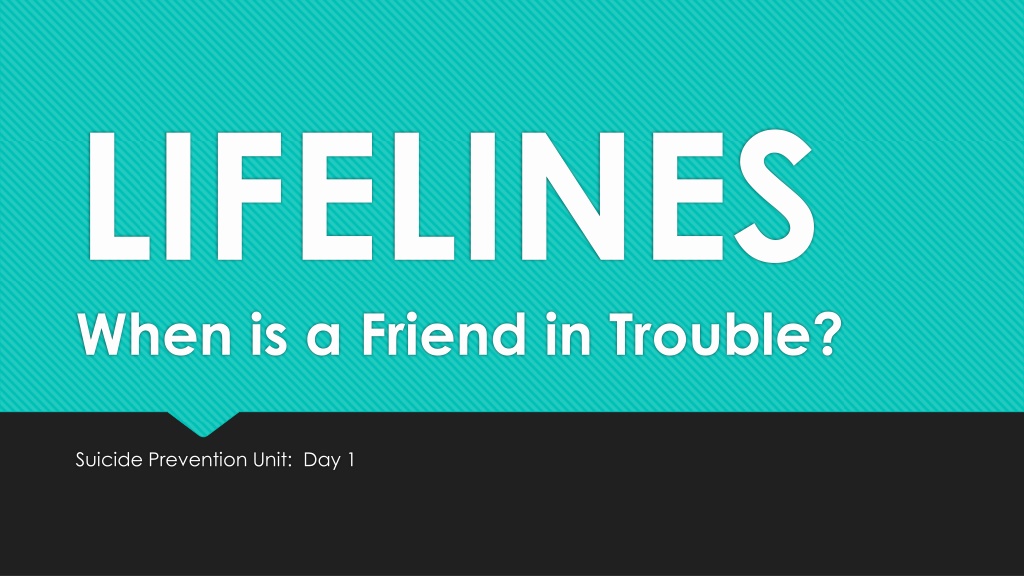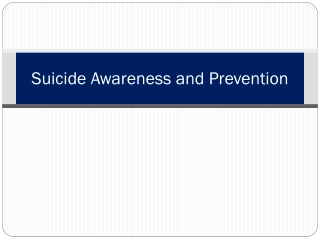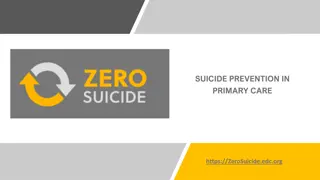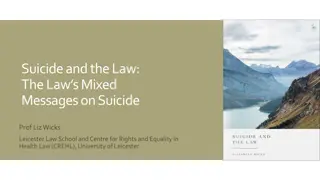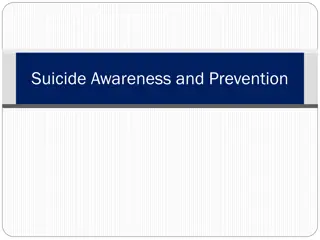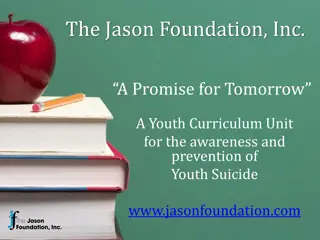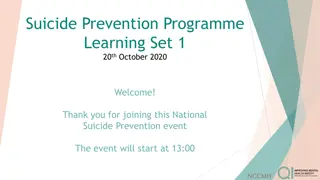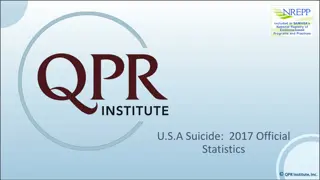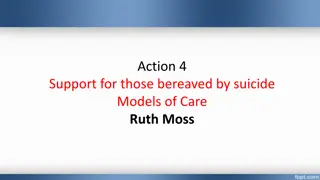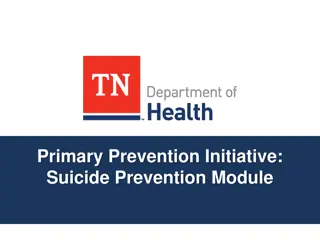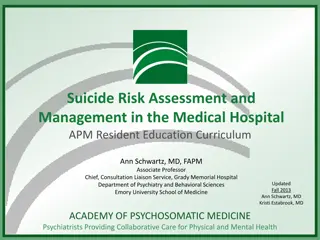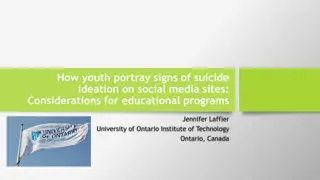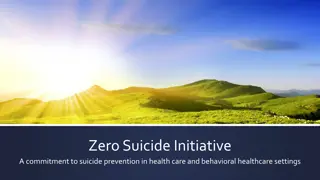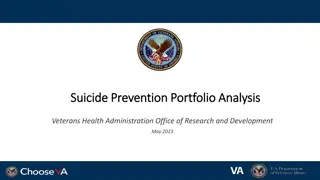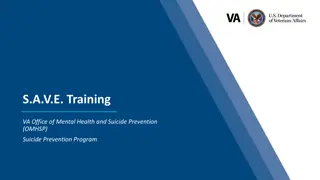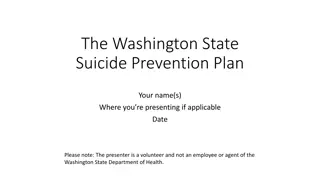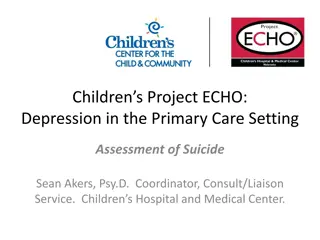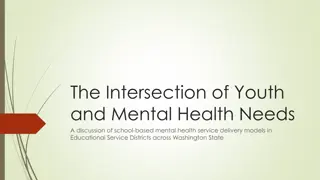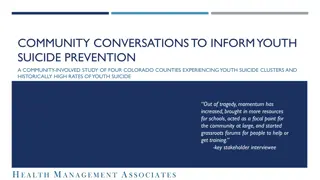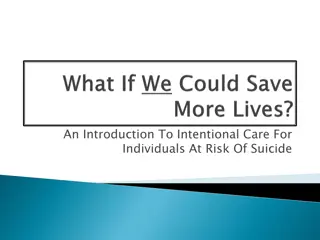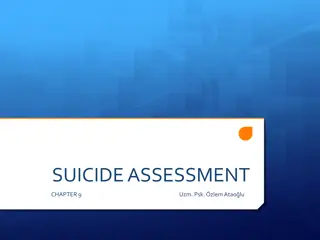Understanding Suicide Prevention for Young People
In this series of visual aids, important information about suicide prevention is highlighted. The images cover statistics, misconceptions, and facts surrounding suicide, emphasizing the importance of taking suicidal communications seriously and debunking myths. It sheds light on the prevalence of suicide among different socioeconomic groups, genders, and the misconception that a person is forever suicidal once they exhibit such feelings. The message is clear that with professional help, individuals with suicidal thoughts can be assisted effectively.
Download Presentation

Please find below an Image/Link to download the presentation.
The content on the website is provided AS IS for your information and personal use only. It may not be sold, licensed, or shared on other websites without obtaining consent from the author. Download presentation by click this link. If you encounter any issues during the download, it is possible that the publisher has removed the file from their server.
E N D
Presentation Transcript
LIFELINES When is a Friend in Trouble? Suicide Prevention Unit: Day 1
By this time tomorrow 12 the ages of 15 - 24 will have killed themselves. young people between
A young person dies by SUICIDE about every 2 hours.
How many people have heard about someone in our school or community who has made an attempt at suicide? How many of you have heard of someone who has died of suicide? How many of you have personally known someone who has made a suicide attempt or died of suicide?
People who talk about suicide do not actually kill themselves. Most people who die by suicide talk to at least one other person about their suicidal feelings or plans before they decide to act on them. It is EXTREMELY important to take these communications seriously! FALSE
Suicide happens equally as often among rich, middle class & poor. Suicidal teens come from all types of families: Rich, poor, popular as well as people of all races, genders, faiths and cultures. TRUE
Males die by suicide more often than females. Men die more frequently than women, however women make more attempts. Women use methods that are less lethal and give the person time to be rescued or change their minds. TRUE
Once a person is suicidal, They are suicidal forever. People can be helped. With help from a professional, the vast majority of people with suicidal thoughts or suicide attempts do not go on to kill themselves. FALSE
If a person feels better after a suicide attempt, it means they will likely not try to do it again. FALSE are made in a persons life, they are at risk for another attempt.+- If the attempt brings attention, the person may feel better for a little while, but unless changes
Suicidal people really want to die. Sometimes this may be true but most times, suicidal people want to escape the terrible way they are feeling. Suicidal people are emotionally mixed-up at the time and most are grateful for intervention. FALSE
Talking about suicide or asking someone about suicide may put the idea of suicide in a person s head and cause suicide. FALSE Actually, the opposite is often true. Asking directly about suicide can help people who feel like there is no one to talk to. Sharing these thoughts can lead to LESS attempts of suicide.
People who threaten to kill themselves are just seeking attention. You can never dismiss the threat of suicide. If someone is that desperate for attention, suicide can never be ruled out as a possibility, even if just for the attention. FALSE
Suicide happens without warning signs. Most people give clues that they are thinking about taking their lives. Usually a person shows more than one sign. Only a small percentage of people show no warning signs. FALSE
WARNING SIGNS OF SUICIDE Threats Actions Changes Situations Feelings
F E E L I N G S Hopelessness feeling like things are bad and won t get better. Fear of losing control, going crazy, harming oneself or others. Helplessness a belief that there s nothing that can make life better. Worthlessness feeling useless or of no value. Self-Hate, guilt or shame Extreme sadness or loneliness Anxiety or worry Feelings
A C T I O N S Drug or alcohol abuse. Talking or writing about death or destruction. Aggression Recklessness Actions
C H A N G E S Personality behaving like a different person, becoming withdrawn, feeling tired all the time, not caring about anything or becoming more talkative or outgoing. Behavior inability to concentrate. Sleeping pattern sleeping all the time or not being about to sleep. Eating habits loss of appetite and/or overeating. Losing interest in friends, hobbies or personal appearance. Changes Sudden improvement after a period of being down or withdrawn.
T H R E A T S Statements like How long does it take to bleed to death? Threats like I won t be around much longer or You d be better off without me. Making plans, such as studying about ways to die or obtaining the means to self- inflict injury or death. Suicide attempts. Threats
S I T U A T I O N S Getting in trouble at school, at home or with the law. Recent losses Changes in life that feel overwhelming. Being exposed Being exposed to suicide or the death of a peer under any circumstances. Situations
How can you help a friend in need? Follow these three steps: Find the words to show you care about your friend. Convince your friend to ask for help.
